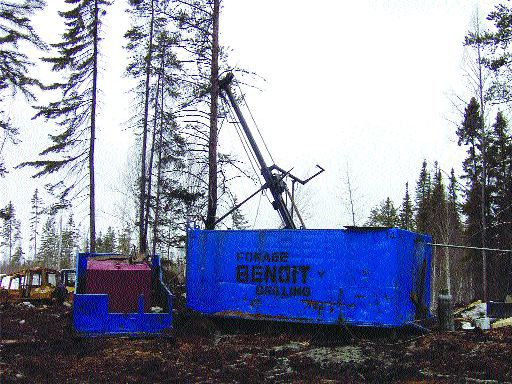A 23.6-metre-wide zone averaging 12.5 grams gold per tonne and 1.1% copper was intersected during a second round of drilling, some 570 metres below surface and 190 metres below the deepest level of the mine. The estimated true width of the intersection is 10.5 metres. The zone comprises veins and stringers of semi-massive magnetite and chalcopyrite containing visible gold in altered mafic syenite. A higher-grade section of the zone averaged 20.3 grams gold and 2% copper over 10.9 metres, representing a true width of 4.8 metres.
Queenston described hole 05-16, which passed through five other significant mineralized intervals in addition to the new discovery, as the best exploration hole it has drilled in the Kirkland Lake camp for 20 years.
The 100%-owned Upper Beaver property is in the northeastern part of Gauthier Twp. It comprises 32 claims collectively covering a little more than 5 sq. km. Gold was first discovered on the property in 1912 and two shafts were sunk exploring a series of gold-copper mineralized veins. In 1919, Argonaut Gold Mines built a small mill, with limited production occurring until 1928. A variety of companies carried out exploration on the property between 1935 and 1964, with no reported production. Upper Canada Gold Mines (a predecessor to Queenston) acquired the property in 1964 and worked the mine to a depth of 365 metres until it was closed in 1971.
Over its life, the Upper Beaver mine produced some 130,000 oz. gold and an undisclosed amount of copper from 505,000 tonnes of mined material grading 7.9 grams gold and 1% copper. A mineral resource of 180,000 tonnes averaging 7.9 grams gold and 1.2% copper was left behind when the mine closed. The historic resource estimate is not compliant with National Instrument 43-101.
Underlying the Upper Beaver property are mafic volcanic rocks of the Kenojevis group to the north and felsic volcanic rocks of the Gauthier group to the south. A syenite plug intrudes the mafic volcanic package north of the shaft. Gold-copper mineralization occurs in northeast-striking quartz-carbonate veins hosted in syenite and mafic volcanics, and in chalcopyrite-pyrite-magnetite zones consisting of northeast-trending layered and non-layered vein styles hosted in andesite and interflow rocks.
The property was explored under a joint venture between Queenston and Pamorex Minerals, a predecessor to Royal Oak Mines, from 1989 to 1997. Significant intercepts from drilling carried out in the early ’90s included: 8.7 grams gold over 11.6 metres in hole 89-4; 10.3 grams gold and 0.9% copper across 4.7 metres in hole 90-3; and 5.5 grams gold and 0.4% copper over 15.4 metres in hole 91-12. These mineralized sections lie beneath the old mine workings.
Bankruptcy forced Royal Oak to withdraw from the joint venture in 2000. That same year, Queenston targeted the North zone with a single hole, intersecting 3.9 grams gold and 0.9% copper over a 2.3-metre width, 300 metres below surface. Previous drilling in 1992 had yielded 5.5 grams gold and 1% copper across 18.9 metres.
The Kirkland Lake camp has produced 37 million oz. gold from 28 mines since gold was first discovered by prospectors at Swastika in 1906. The recent exploration success of
Queenston is well positioned in the camp, with land holdings of 28 properties covering 138 sq. km in three townships: Teck, Lebel and Gauthier. The properties are centred on the Larder Lake Break, a regional structure along which many of the gold deposits occur.
With the belief that a program of concentrated, deeper exploration drilling will lead to the discovery of new gold deposits along proven mine trends, Queenston embarked on an aggressive $3-million exploration program in 2005.
As part of a planned 30,000-metre regional drill program, Queenston began drilling on the Upper Beaver property in May, testing a variety of geophysical and geological targets. During the previous winter, an induced-polarization (IP) survey outlined a series of east-west anomalies trending across the property.
During the first round, eight holes totalling 3,160 metres were completed. The highlight of this drilling was the intersection of a flat-lying gold horizon over a strike length of 200 metres.
Significant values include the following:
– 5.9 grams gold over 2.1 metres and 8.5 grams across 1.9 metres in hole 05-1;
– 14.3 grams gold over 3 metres in hole 05-3; and
– 9.2 grams gold across 4 metres in hole 05-4.
The horizon, referred to as the Contact zone, is located to the south of and below the mine workings, occurring between upper mafic rocks of the Kinojevis group and lower felsic pyroclastic and cherty sediments of the Gauthier group. This horizon was partially tested by previous drilling and was indicated by an earlier induced-polarization (IP) survey to have a strike length of 900 metres.
In the second round of drilling comprising 11 holes or 5,260 metres, Queenston extended the strike length of the Contact zone to 600 metres by intersecting the following:
– 10.9 metres of 5 grams gold, followed by 10.3 metres of 3.8 grams gold in hole 05-17;
– 4.2 metres of 13.4 grams in hole 19; and
– 12.5 grams gold and 1.1% copper across 23.6 metres (10.5 metres true width) in hole 05-16, the highlight of the second phase of drilling.
Hole 05-16 also intersected a number of other gold zones including three intersections in the Central zone assaying 2 grams gold across 17.6 metres, 2 grams over 13 metres and 29.2 grams across 4.8 metres. The Upper Contact zone averaged 2.7 grams gold across 8.3 metres, and the Lower Contact zone averaged 4.5 grams over 14.2 metres.
Queenston is preparing to begin a third round of follow-up drilling consisting of 12 holes totalling 7,000 metres to further test the new discovery and to expand the Contact and Central zones.


Be the first to comment on "Renewed activity around past-producer Upper Beaver"